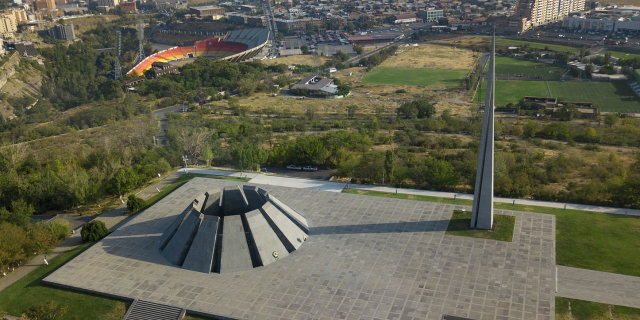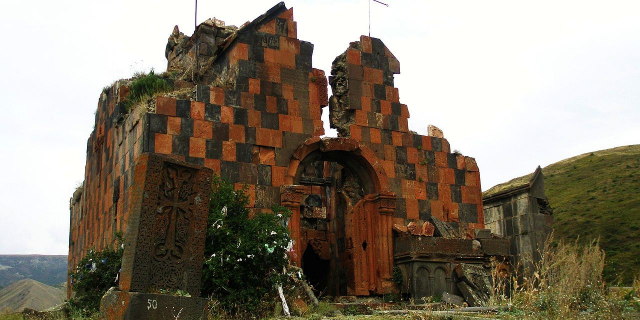Ani Katedrali
( Cathedral of Ani )
The Cathedral of Ani (Armenian: Անիի մայր տաճար, Anii mayr tačar; Turkish: Ani Katedrali) is the largest standing building in Ani, the capital city of medieval Bagratid Armenia, located in present-day eastern Turkey, on the border with modern Armenia. Its construction was completed in the early 11th century by the architect Trdat and it was the seat of the Catholicos, the head of the Armenian Apostolic Church, for nearly half a century.
In 1064, following the Seljuk conquest of Ani, the cathedral was converted into a mosque. It later returned to being used as an Armenian church. It eventually suffered damage in a 1319 earthquake when its conical dome collapsed. Subsequently, Ani was gradually abandoned and the church fell into disrepair. The north-western corner of the church was heavily damaged by a 1988 earthquake.
The cathedral is considered the largest and most impressive structure ...Read more
The Cathedral of Ani (Armenian: Անիի մայր տաճար, Anii mayr tačar; Turkish: Ani Katedrali) is the largest standing building in Ani, the capital city of medieval Bagratid Armenia, located in present-day eastern Turkey, on the border with modern Armenia. Its construction was completed in the early 11th century by the architect Trdat and it was the seat of the Catholicos, the head of the Armenian Apostolic Church, for nearly half a century.
In 1064, following the Seljuk conquest of Ani, the cathedral was converted into a mosque. It later returned to being used as an Armenian church. It eventually suffered damage in a 1319 earthquake when its conical dome collapsed. Subsequently, Ani was gradually abandoned and the church fell into disrepair. The north-western corner of the church was heavily damaged by a 1988 earthquake.
The cathedral is considered the largest and most impressive structure in Ani. It is a domed basilica with a rectangular plan, though the dome and most of its supporting drum are now missing. Its use of pointed arches and cluster piers has been widely cited by scholars to have possibly influenced, or at least preceded, Gothic architecture. The cathedral, along with the entire site of Ani, was declared a World Heritage Site by the UNESCO in 2016.
Following more than two centuries of Arab rule, Armenia gained independence under the Bagratid (Bagratuni) dynasty around 885. King Ashot III made Ani capital in 961, after which the city emerged as a prosperous urban center with 100,000 residents at its height.[1][2][3] The construction of the cathedral began in 989.[4] The architect Trdat was commissioned by Bagratid King Smbat II to build a cathedral in the new capital of the Armenian kingdom.[5][6] The construction was halted when Smbat died in 989, according to an inscription on the south wall.[7][8] Meanwhile, Trdat was hired to direct the repairs of the dome of the Hagia Sophia in Constantinople, which had collapsed in an earthquake.[9][4] Trdat returned from Constantinople in 993.[10] The construction was continued and completed by Queen Katranide[13] (Katramide),[16] the wife of King Gagik I, Smbat's brother and successor.[7] It was completed either in 1001 or 1010.[27] According to Christina Maranci the generally accepted date of completion is 1001, but it may have extended until 1010.[5] The contradiction is based on the reading of the inscription of the cathedral's northern wall.[28][29] The cathedral served as the seat of the catholicos,[14] the head of the Armenian Apostolic Church from its foundation in 1001[30] until the mid-11th century (1046 or 1051).[31][32] Thus, for around half a century Ani was both the religious and secular (political) center of Armenia.[30]
A silver cross originally stood on its conical dome and a crystal chandelier, bought by King Smbat II from India, hang in the cathedral. In the 1010s, during the reign of Catholicos Sarkis I, a mausoleum dedicated to the Hripsimean virgins was erected next to the cathedral. The mausoleum was built on some of the remnants of the virgins brought from Vagharshapat (Etchmiadzin).[14] In the 1040s–1050s inscriptions were left on the cathedral's eastern and western walls about urban projects, such as restoration of defensive walls, installation of water pipes and easing of the tax burden on the residents of Ani.[8]


![Cross section of the church per Toros Toramanian[33]](http://upload.wikimedia.org/wikipedia/commons/thumb/2/27/Ani_Cathedral_cross_section.png/261px-Ani_Cathedral_cross_section.png)
![Reconstruction by Toramanian[a]](http://upload.wikimedia.org/wikipedia/commons/thumb/c/c9/Ani_Cathedral_model_by_Toros_Toramanian.png/215px-Ani_Cathedral_model_by_Toros_Toramanian.png)
![Reconstruction by Wilhelm Lübke (1881)[34]](http://upload.wikimedia.org/wikipedia/commons/thumb/b/b8/Ani_Cathedral_reconstruction_by_Wilhelm_L%C3%BCbke.jpg/213px-Ani_Cathedral_reconstruction_by_Wilhelm_L%C3%BCbke.jpg)
![ground plan[35][4]](http://upload.wikimedia.org/wikipedia/commons/thumb/9/93/Anii_Mayr_Tacar_plan.jpg/114px-Anii_Mayr_Tacar_plan.jpg)
Ani surrendered to the Byzantine Empire in 1045, who held it until 1064, when the city was captured by the Seljuks, led by Alp Arslan.[36] Alp Arslan and his soldiers performed their first prayer in Ani at the cathedral.[37] Consequently, the cathedral was converted into a mosque[8][38] and called Fethiye Mosque[39][40] (Turkish: Fethiye Camii).[44][b] Official Turkish sources often refer to it by that name.[48]
In 1124 a crescent was placed on the cathedral's dome by the Shaddadid amir of Ani. In response, Ani's Armenians appealed to King David IV of Georgia to capture Ani, after which the cathedral returned to Christian usage.[8][29] However, only two years later, in 1126, Ani came under the control of the Shaddadids.[8] During the 12th century historians Mkhitar Anetsi, Samuel Anetsi and philosopher Hovhannes Sarkavag served at the cathedral in various capacities.[8] Mkhitar was an elder priest at the cathedral in the second half of the century.[49] In 1198 Ani was conquered by the Georgian-Armenian Zakarid (Mkhargrdzeli) princes, under whose control the cathedral prospered. In 1213 the wealthy merchant Tigran Honents restored the cathedral's steps.[8]
 Damage done to the cathedral by the 1988 earthquake.Decay
Damage done to the cathedral by the 1988 earthquake.Decay
Ani's long-term decline began in 1239 when Mongols sacked the city and massacred its population.[50] In 1319 a devastating earthquake struck Ani. It resulted in the collapse of the cathedral's conical roof.[8][11][29] Ani was completely deserted by the 18th century.[51] The drum reportedly collapsed during an 1832[29] or 1840[52] earthquake. Varazdat Harutyunyan insists that the entire dome had collapsed in 1319.[15]
The north-western corner of the cathedral was heavily damaged by a 1988 earthquake with its epicenter in modern Armenia's north.[8] It resulted in a large gaping hole. According to VirtualAni it also caused "a serious rent in the south-west corner; by 1998 parts of the roof here had started to fall."[29] Lavrenti Barseghian wrote in 2003 that the damage from the earthquake was so great that the entire building would collapse unless strengthened and restored.[53]
Explosions in a quarry on the Armenian side of the border, across the Akhurian River, reportedly caused some damage to the cathedral in the early 2000s.[54][29] In mid-June 2001 an "ear-splitting explosion rocked the site just as a group of Armenian Americans had gathered to pray at the cathedral."[55] Armenian architectural historian Samvel Karapetyan, who witnessed the explosions on the Armenian side during his visit to Ani in July 2000, stated that the explosions continued until 2004/2005.[56] However, Turkish accusations continued until 2008.[38] According to Vercihan Ziflioğlu, writing for the Hürriyet, it was only in 2009 that Armenia halted blasting activities, reportedly, after Turkey's complaint at the International Council on Monuments and Sites (ICOMOS).[57]
In the mid-2000s, Turkish guards had dug a large hole in their quest for treasure on the floor of the apse of the cathedral. Moreover, treasure hunters dug out the grave of what may have been that of Queen Katranide beside the west façade of the cathedral. It had been uncovered by French archaeologists in 2002–03. Additional gravestones with Armenian inscriptions nearby were upturned.[58]
Cite error: There are <ref group=lower-alpha> tags or {{efn}} templates on this page, but the references will not show without a {{reflist|group=lower-alpha}} template or {{notelist}} template (see the help page).


























![[node:title]](/sites/default/files/styles/640x320/public/pla/images/2021-03/Monasterio_Khor_Virap%2C_Armenia%2C_2016-10-01%2C_DD_25.jpeg?h=7c882872&itok=TSlbC6VX)



Add new comment